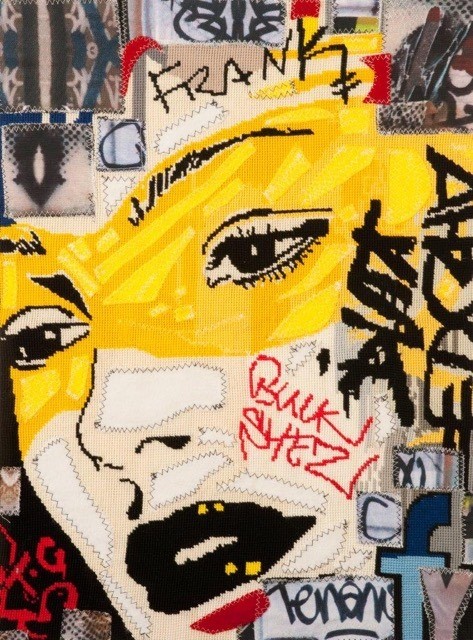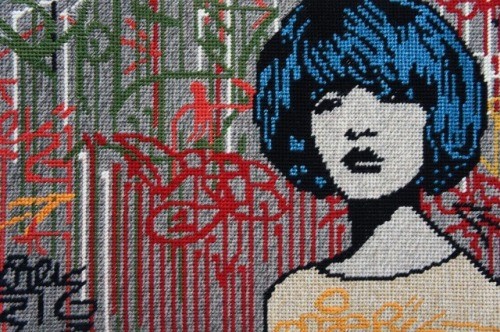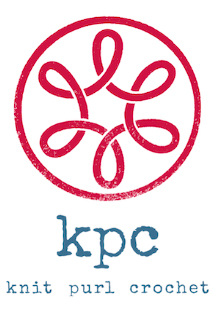By Ingrid Keneally
Australian textile artist Niki McDonald uses needle point on canvas to create brilliant works that somehow have all the urban boldness and edge of traffic-stopping graffiti art or mysteriously beautiful sleeper portraits hiding on the walls of city tunnels. Her work throws back to the old technique of tapestry but is reinvigorated with a modernity that makes them quite fascinating. At the art school where McDonald trained in the 80s, there was a particular emphasis on the Bauhaus method, but there she was also introduced to painting, collage, printmaking and sculpture, whose influences are all evident in her richly textured, layered work.
- How do you work with wool?
To begin a new piece, I start by taking photos of our vibrant and ephemeral urban landscape and use them as inspiration to paint the tapestry canvases. I paint strong images of women’s faces over the backgrounds and allow the colours to show through. I’m saying that the colours and shapes from our streets empower these women and give them sass and individuality. I am drawn to colour, ply and texture and seek the wool that will best represent my intention. I try to limit my colours to around six and bring the image together with key black lines. Sometimes I use the repetition of the half cross stitch to emulate the pixilation in dot matrix, and at other times I try to create a more chaotic experience by changing the cross stitch size.

- If you could choose one pivotal moment in your career, what would it be?
In 2012 and 2013 when I won prizes and first place in a variety of art prizes. It was validating and reassured me that the textile medium I had chosen was successfully expressing my creativity.
- Are there any experiences in your childhood or adolescence that have positively impacted what you do now?
I grew up in a household filled with creativity and making art was as natural to me as playing with toys. I sat with my nana as she knitted beautiful jumpers and played with the wool. Later, my mum bought me a weaving loom for my eighth birthday. I spent hours experimenting and pushing its boundaries. In high school I picked up needlepoint tapestry, my teacher was supportive, probably because it was containable, clean and kept me quiet. I still have a large tiger that I painted then diligently sewed and handed in as one of my senior major works.

- What are the professional achievements you are most proud of?
Winning the International Women’s Day art prize; having two large exhibitions every year, and making enough money with sales to support my art practice. A recent moment that stands out for me and cemented my true love of textiles was at my tapestry workshop in Gallery One88 in Katoomba. Adults, couples, teenagers and kids signed up for the workshop. Everyone received a 30 cm x 40 cm, 5 count tapestry canvas that I had painted with simple shapes and colours. The group learned quickly and it was a smooth transition to them finding their flow. People were selecting their wool, threading up, stitching and admiring their handiwork. There was no Wi -Fi or screens and I could literally see the makers being soothed by the act of focusing and creating. The next day I had parents report back to me that their kids took their tapestries to dinner, sewed them over breakfast and were completely screen free, which is a miracle in the age that we live in.
- If there is one thing you wish you’d known when you were starting out in wool, what would it be?
One thing that I wish I had known about wool when I first started was that I didn’t only have to use DMC tapestry wool. As good as it is I found it restrictive in ply and costly in quantity. My work ached to grow and I wanted to maximize the medium - it was this desire for expansion that led me to try any wool that was on the market. I now source my wool for its qualities and how they will facilitate the finished piece.
- Why do you think wool and handmade textiles are so fashionable right now?
Because people need something real to point to at the end of the day to reinforce their humanness. Hours spent on social media and the internet are just not soothing the soul. Anxiety and depression is at an all-time high and people are in danger every day of being frazzled and disconnected. The process of making, problem solving, evaluating and extending creativity brings people back to their ancestral roots. The act of buying and supporting creativity allows those who can’t prioritize making to feel that they are part of the process.

- What is your dream wool project?
To create a piece that is over two metres in size using 3 count tapestry canvas and really maximising the medium. I’m in a bigger is better place, I want textile art to stand proud and be noticed.
- Who are the artists who have most greatly inspired you?
In 2003 I visited the Art Gallery of NSW and was completely engaged and inspired by Tracey Emin’s textile art pieces. Her pieces were visceral and her message was accentuated by the use of cloth, stitching and wool. I was then struck by the permanency of Joseph Beuys' artworks and his use of stitching and grey felt. I now follow the most amazing textile artists on Instagram and marvel at their wonderful and diverse use of wool. Artists like Natalie Miller, Erin Riley, Liz Payne, Jacqui Fink and Megan Shimek and many more inspire and engage me every day.
- What is your favorite woollen item in your wardrobe or home?
My favourite woollen item in my wardrobe is an intricately crocheted charcoal grey alpaca shawl made by my father-in-law Garry McDonald while he waited for his scenes doing a theatre production. It’s stunningly made, warm and elegant.
- Where do you work?
Once I have painted my tapestry canvas and sourced the wool I am free to sew wherever I go. Most of the time I work on a big comfy rug at home while I listen to audio books and watch TED talks. I feel lost and fidgety if I’m not sewing so the works come with me visiting friends, on car trips and train trips, on holidays and picnics.
- What is your idea of a good beginner’s task?
Buy some tapestry canvas, draw or trace a simple image on it, select some wool that will keep you motivated and start with the half cross stitch. With a bit of persistence the piece will begin to grow and take shape.
- Which is the KPC Yarn hue that really speaks to you?
I am in love with the Peacock and the Flame from the KPC Yarn, Glencoul Chunky range. The depth of colour and strength draws me to the Glencoul chunky and the vibrancy helps my tapestries to pop.
Follow Niki McDonald on Instagram and blog.
